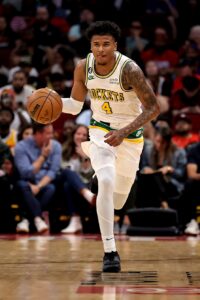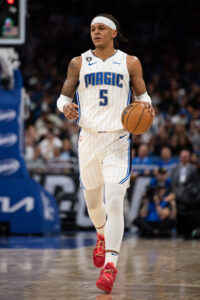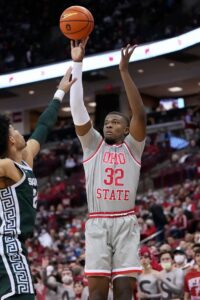We’re using the space below to keep tabs on each NBA team’s second round pick for 2024, continually updating it as necessary throughout the year. Our list of traded first round picks for 2024 can be found right here.
We’ve listed all 30 teams here, so even if a team hasn’t traded its second round pick, that will be noted. We’ll also provide details on protections for each traded pick, including what happens to the pick in 2025 if it doesn’t change hands in 2024.
Here’s the full breakdown on the status of each 2024 second-round pick:
Atlantic
- Boston Celtics: Traded to Mavericks.
- Brooklyn Nets: Traded to Grizzlies or Rockets (55-58 protection).
- If this pick lands in the top 54, the Grizzlies will receive the most favorable of the Warriors’ and Nets’ 2024 second round picks and the Rockets will receive the least favorable; if this pick lands between 55-58, the Nets would keep it and their obligation to Memphis or Houston would be extinguished.
- New York Knicks: Traded to Pistons.
- Philadelphia 76ers:
Own pick.- The Sixers will forfeit this pick due to free agency gun-jumping.
- Toronto Raptors: Traded to Pacers or Clippers.
- Details at bottom of page.
Central
- Chicago Bulls: Traded to Sixers, Pacers, or Warriors.
- The Sixers will receive the most favorable of the Bulls’ and Pelicans’ 2024 second round picks; the Pacers will receive the least favorable of the two. The Pacers may subsequently flip their pick to the Warriors (details at bottom of page).
- The Sixers will receive the most favorable of the Bulls’ and Pelicans’ 2024 second round picks; the Pacers will receive the least favorable of the two. The Pacers may subsequently flip their pick to the Warriors (details at bottom of page).
- Cleveland Cavaliers: Traded to Knicks, Clippers, Pacers, or Warriors.
- Details at bottom of page.
- Details at bottom of page.
- Detroit Pistons: Traded to Raptors.
- Indiana Pacers: Traded swap rights to Clippers.
- Details at bottom of page.
- Milwaukee Bucks: Traded to Pacers or Warriors.
- Details at bottom of page.
Southeast
- Atlanta Hawks: Traded to Trail Blazers.
- Charlotte Hornets: Traded to Trail Blazers or Nuggets.
- The Trail Blazers will receive the most favorable of the Hornets’ and Timberwolves’ 2024 second round picks; the Nuggets will receive the least favorable of the two.
- The Trail Blazers will receive the most favorable of the Hornets’ and Timberwolves’ 2024 second round picks; the Nuggets will receive the least favorable of the two.
- Miami Heat: Possibly traded to Hawks or Knicks.
- The Hawks would receive this pick if it lands between 51-55; the Knicks would receive it if it lands between 56-58; the Heat would keep it if it lands in the top 50. If the Heat keep the pick, their obligations to the Hawks and Knicks would be extinguished.
- The Hawks would receive this pick if it lands between 51-55; the Knicks would receive it if it lands between 56-58; the Heat would keep it if it lands in the top 50. If the Heat keep the pick, their obligations to the Hawks and Knicks would be extinguished.
- Orlando Magic: Own pick.
- Washington Wizards: Traded to Jazz or Timberwolves.
- The Jazz will receive the most favorable of the Wizards’ and Grizzlies’ 2024 second round picks; the Timberwolves will receive the least favorable of the two.
Northwest
- Denver Nuggets:
Traded to Suns.- The Suns will forfeit this pick due to free agency gun-jumping.
- Minnesota Timberwolves: Traded to Trail Blazers or Nuggets.
- The Trail Blazers will receive the most favorable of the Timberwolves’ and Hornets’ 2024 second round picks; the Nuggets will receive the least favorable of the two.
- Oklahoma City Thunder: Traded to Grizzlies.
- Portland Trail Blazers: Traded to Bucks.
- Utah Jazz: Traded to Knicks, Clippers, Pacers, or Warriors.
- Details at bottom of page.
Pacific
- Golden State Warriors: Traded to Grizzlies, Rockets or Cavaliers.
- If this pick lands in the top 55, the Grizzlies will receive the most favorable of the Warriors’ and Nets’ 2024 second round picks and the Rockets will receive the least favorable; if this pick lands between 56-58, the Cavaliers would receive it. The Warriors’ obligation to the team that doesn’t receive the pick will be extinguished.
- If this pick lands in the top 55, the Grizzlies will receive the most favorable of the Warriors’ and Nets’ 2024 second round picks and the Rockets will receive the least favorable; if this pick lands between 56-58, the Cavaliers would receive it. The Warriors’ obligation to the team that doesn’t receive the pick will be extinguished.
- Los Angeles Clippers: Traded to Lakers.
- Los Angeles Lakers: Traded to Spurs.
- Phoenix Suns: Traded to Wizards.
- Sacramento Kings: Own pick.
Southwest
- Dallas Mavericks: Traded to Celtics.
- Houston Rockets: Traded to Hornets.
- Memphis Grizzlies: Traded to Jazz or Timberwolves.
- The Jazz will receive the most favorable of the Grizzlies’ and Wizards’ 2024 second round picks; the Timberwolves will receive the least favorable of the two.
- New Orleans Pelicans: Traded to Sixers, Pacers, or Warriors.
- The Sixers will receive the most favorable of the Bulls’ and Pelicans’ 2024 second round picks; the Pacers will receive the least favorable of the two. The Pacers may subsequently flip their pick to the Warriors (details at bottom of page).
- The Sixers will receive the most favorable of the Bulls’ and Pelicans’ 2024 second round picks; the Pacers will receive the least favorable of the two. The Pacers may subsequently flip their pick to the Warriors (details at bottom of page).
- San Antonio Spurs: Possibly traded to Suns or Celtics.
- The Suns would receive this pick if it lands between 50-54; the Celtics would receive it if it lands between 55-58; the Spurs would keep it if it lands in the top 49. If the Spurs keep the pick, their obligations to the Suns and Celtics would be extinguished.
Here are the details on how the Raptors‘, Cavaliers‘, Pacers‘, and Jazz‘s second round picks will be distributed:
The Knicks will receive the most favorable of:
- The Jazz’s 2024 second round pick.
- The Cavaliers’ 2024 second round pick.
The Pacers will receive the most favorable of:
- The Raptors’ 2024 second round pick.
- The most favorable of the Pacers’ 2024 second round pick and the Jazz/Cavaliers 2024 second round pick that the Knicks didn’t acquire.
If the Pacers don’t receive the Raptors’ 2024 second round pick, the Clippers will receive it and the Pacers will end up with the other two picks. If the Pacers do receive the Raptors’ 2024 second round pick, the Clippers will receive the most favorable of the two remaining picks and the Pacers will receive the least favorable.
From there, the Pacers will send the least favorable of the following picks to the Warriors:
- The least favorable pick of the two they receive based on the guidelines outlined above.
- The least favorable of the Bulls’ and Pelicans’ picks.
- The Bucks’ pick.
Information from RealGM was used in the creation of this post.




 He has four years of NBA experience (ie. a player with five years of experience who missed two full seasons due to injuries would not be eligible).
He has four years of NBA experience (ie. a player with five years of experience who missed two full seasons due to injuries would not be eligible). A player on a two-way contract can be converted without his consent. In that scenario, he would receive the minimum salary for the remaining term of his contract. A player on a one-year two-way contract would get a one-year, minimum-salary standard contract, while a player with two years left on his two-way deal would get a two-year, minimum-salary standard contract.
A player on a two-way contract can be converted without his consent. In that scenario, he would receive the minimum salary for the remaining term of his contract. A player on a one-year two-way contract would get a one-year, minimum-salary standard contract, while a player with two years left on his two-way deal would get a two-year, minimum-salary standard contract.